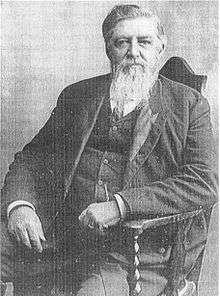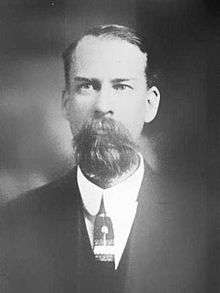William Smith (Latter Day Saints)
| William Smith | |
|---|---|
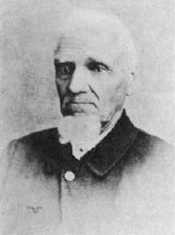 | |
| Petitioner for Patriarchate (RLDS Church) | |
| April 6, 1872 – November 13, 1893 | |
| Predecessor | None |
| Successor | Alexander Hale Smith |
| Reason | Doctrine of Lineal succession |
| 3rd Presiding Patriarch (LDS Church) | |
| May 24, 1845 – October 6, 1845 | |
| End reason | Removed from position by a vote of the church |
| Quorum of the Twelve Apostles | |
| May 25, 1839 – October 6, 1845 | |
| End reason | Removed from Quorum by a vote of the church |
| Quorum of the Twelve Apostles | |
| February 15, 1835 – May 4, 1839 | |
| End reason | Removed from Quorum by a vote of the church |
| Latter Day Saint Apostle | |
| February 15, 1835 – October 6, 1845 | |
| Reason | Initial organization of Quorum of the Twelve |
| End reason | Excommunication for apostasy[1] |
| Reorganization at end of term | No apostles ordained[2] |
| Personal details | |
| Born |
March 13, 1811 Royalton, Vermont, United States |
| Died |
November 13, 1893 (aged 82) Osterdock, Iowa, United States |
| Resting place | Osterdock - Bethel Chapel Cemetery |
William Smith (also found as William B. Smith) (March 13, 1811 – November 13, 1893) was a leader in the Latter Day Saint movement and one of the original members of the Quorum of the Twelve Apostles. Smith was the eighth child of Joseph Smith Sr. and Lucy Mack Smith and was a younger brother of Joseph Smith Jr., the founder of the Latter Day Saint movement.
Early life
Born in Royalton, Vermont, Smith and his family suffered considerable financial problems and moved several times in the New England area. He was living in the home of his parents near Manchester, New York, when his brother Joseph reported that he had taken golden plates from the hill Cumorah. William was told by Joseph that he could not view the golden plates but was allowed to reach into the case and feel what Joseph said were the plates. William was baptized into his brother's Church of Christ on June 9, 1830, by David Whitmer, one of the Three Witnesses to the golden plates.
Church leadership
On February 14, 1835, the Three Witnesses designated Phineas Young, brother of Brigham, as one of the inaugural members of the Quorum of the Twelve. However, Joseph Smith insisted that his own younger brother, William, be selected instead. Oliver Cowdery and David Whitmer later reported that William's selection was "contrary to our feelings and judgment, and to our deep mortification ever since."[3] William Smith was ordained an apostle on February 15.
On May 4, 1839, Smith and Orson Hyde were suspended from the Quorum of the Twelve by a vote of the church;[4] however, Smith was readmitted to the Quorum on May 25.[5] From April to December 1842, Smith was the editor of The Wasp, a secular but pro-Mormon newspaper in Nauvoo, Illinois.[6] Smith was fierce in his editorial criticism of the anti-Mormon newspaper the Warsaw Signal and its editor Thomas C. Sharp, whom Smith referred to in the Wasp as "Thom-ASS C. Sharp".[6][7] Smith resigned as the editor of The Wasp after he was elected to the Illinois General Assembly, and he was succeeded by fellow-apostle John Taylor, who edited The Wasp for another five months before replacing it with the Nauvoo Neighbor.[8]
On May 24, 1845, Smith succeeded his late brother Hyrum Smith as the Presiding Patriarch of the church.[9] Shortly after his ordination to this position, Brigham Young printed a clarification in a church newspaper that stated that Smith had not been ordained as patriarch over the church, but rather as patriarch to the church;[10] Smith regarded this clarification as a slight, and it exacerbated the growing tension between Smith and Young. Smith was patriarch to the church until October 6, 1845, when his name and positions were read at general conference, but fellow apostle Parley P. Pratt expressed objections due to his character and practices. The conference attenders unanimously voted against Smith being retained as both an apostle and the patriarch, and he lost both offices and was disfellowshipped from the church.[11][12] Smith responded by submitting a lengthy statement to Sharp's Warsaw Signal, in which he compared Young to Pontius Pilate and Nero and accused Young and other members of the Twelve of secretly keeping multiple "spiritual wives".[13] As a result of Smith's statement, Smith was excommunicated from the church by Young and the Quorum of the Twelve Apostles on grounds of apostasy on October 19, 1845.[14]
Relationship with Joseph Smith
The relationship between William and his older brother Joseph was, at times, quite rocky. William is believed to have physically fought with or attempted to fight with Joseph on more than one occasion. In October 1835, a fist fight between the two was narrowly averted.[15] Weeks later, in December, there was an altercation between the two at a debating school being held in their father's home,[16][17] and it is said that at the time Joseph died, he was still suffering the physical effects of the beating that he received.[18]
Later involvement with Latter Day Saint groups
As a result of Smith's excommunication, he did not follow Young and the majority of Latter Day Saints who settled in Utah Territory and established The Church of Jesus Christ of Latter-day Saints (LDS Church). Rather, Smith followed the leadership of James J. Strang and was involved with the Church of Jesus Christ of Latter Day Saints (Strangite).[19]
In 1847, Smith announced that he was the new president of the Latter Day Saint church and that he held a right to leadership due to the doctrine of lineal succession. He excommunicated Young and the leadership of the LDS Church and announced that the Latter Day Saints who were not in apostasy by following Young should gather in Lee County, Illinois.[19] In 1849, Smith gained the support of Lyman Wight, who led a small group of Latter Day Saints in Texas.[19] However, Smith's church did not last, and within a few years it dissolved.
Smith's relationship with Young remained strained until Young's death in 1877. Smith believed that Young had arranged for William's older brother Samuel to be poisoned in 1844 to prevent his accession to the presidency of the church.[20][21][22] However, in 1860, Smith wrote a letter to Young in stating that he desired to join the Latter-day Saints in the Salt Lake Valley.[23] Shortly after sending the letter, Smith became involved as a soldier in the American Civil War, and after the war he did not show any interest in moving to Utah Territory.
In 1878, Smith became a member of the Reorganized Church of Jesus Christ of Latter Day Saints (RLDS Church),[19] which was organized in 1860 with Smith's nephew, Joseph Smith III, as its leader. The majority of William Smith's followers also became members of the RLDS Church. While Smith believed that he was entitled to become the presiding patriarch or a member of the Council of Twelve Apostles of the RLDS Church, his nephew did not agree and William Smith remained a high priest in the RLDS Church for the remainder of his life.[24] Today, the Community of Christ sometimes refers to Smith as "Petitioner for RLDS Patriarchate" from April 6, 1872, until his death.[25]
Lineal succession
| |||||||||||||||||||||||||||||||||||||||||||||||||||||||||||||||||||||||||||||||||||||||||||||||||||||||||||||||||||||||||||||||||||||||||||||||||||||||||||||||||||||||||||||||||||||||||||||||||||||||||||||||||||||||||||||||||||||||||||||||||||||||||||||||||||
Politics
Smith served a term in the Illinois General Assembly in 1842 and 1843, being elected to the Illinois House of Representatives as a representative of Hancock County. Smith ran in the election as a Democrat. His chief opponent was Thomas C. Sharp, an anti-Mormon Whig candidate. Smith won the election easily as a result of overwhelming Mormon support from voters in Nauvoo.[26]
Death
When Smith died at Osterdock, Clayton County, Iowa, he was the last brother of Joseph Smith to die. He was survived by his sisters Sophronia and Katharine.
Publications
- William Smith (1842-1842, newspaper). The Wasp (Nauvoo, Illinois: LDS Church)
- William Smith (Spring 1844). To the Public. Slander Refuted! An Extract from Church Proceedings; and Expulsion of Mormon Apostates, from the Church! (Philadelphia: self-published)
- William Smith (Spring 1844). Defense of Elder Wm. Smith, Against the Slanders of Abraham Burtis and others (Philadelphia: self-published)
- William Smith (Late 1844). The Elders' Pocket Companion (Location unknown: Self-Published)
- William Smith (June 1845). A Proclamation, and Faithful Warning to all the Saints scattered around... (Galena, Illinois: self-published)
- William Smith (October 1845). Faithful Warning to the Latter Day Saints [shorter version of A Proclamation.] (St. Louis, Missouri: self-published)
- William Smith, Arthur Millikin, and Lucy Millikin (April 1846). To the Public (Nauvoo, Illinois: self-published)
- William Smith (September 1847). William Smith, Patriarch & Prophet of the Most High God – Latter Day Saints, Beware of Imposition! (Ottawa, Illinois: Free Press)
- William Smith (November 1848). A Revelation Given to William Smith, in 1847, on the Apostacy of the Church .... (Philadelphia: self-published)
- William Smith and Isaac Sheen (1849–1850, newspaper). Melchisedek & Aaronic Herald (Covington, Kentucky: Isaac Sheen)
- William Smith et al. (1850) Remonstrance of William Smith et al., of Covington, Kentucky. Against the Admission of Deseret into the Union. (Washington D.C.: U.S. Government)
- William Smith (1883). William Smith on Mormonism: A True Account of the Origin of the Book of Mormon (Lamoni, Iowa: RLDS Church)
Notes
- ↑ Smith was disfellowshipped and removed from the Quorum of the Twelve on October 6, 1845. However, Smith remained an apostle until his excommunication. Smith had also been temporarily suspended from the Quorum between May 4 and 25, 1839, by votes of the church.
- ↑ After Smith's removal from the Quorum, Amasa M. Lyman—who had previously been ordained an apostle in 1842—was added to the Quorum of the Twelve. Thus, no new apostles were ordained as a result of Smith's removal from the Quorum or his excommunication.
- ↑ Oliver Cowdery to Brigham Young, February 27, 1848; and Zenas H. Gurley Jr. interview of David Whitmer on January 14, 1885; both in LDS Church History Library.
- ↑ History of the Church 3:345.
- ↑ History of the Church 3:364.
- 1 2 Jerry C. Jolley, "The Sting of the Wasp: Early Nauvoo Newspaper—April 1842 to April 1843", 22 BYU Studies (Fall 1982) 487–96.
- ↑ Wasp, April 30, 1842, p. 2.
- ↑ Darwin L. Hays, "Nauvoo Neighbor" in Daniel H. Ludlow (ed.) (1992). Encyclopedia of Mormonism. (New York: Macmillan) p. 999.
- ↑ History of the Church 7:418.
- ↑ "Patriarchy", Times and Seasons, vol. 6, no. 10 (1845-06-01) pp. 920–22.
- ↑ B. H. Roberts (ed.), History of the Church 7:457–59.
- ↑ Hosea Stout journal, October 6, 1845.
- ↑ William Smith, "A Proclamation", Warsaw Signal, 1845-10-29. The newspaper did not print Smith's statement until after he was excommunicated.
- ↑ B. H. Roberts (ed.), History of the Church 7:483.
- ↑ History of the Church 2:294–95.
- ↑ Arnold K. Garr, "Joseph Smith: Man of Forgiveness," in Susan Easton Black and Charles D. Tate Jr. (ed.), Joseph Smith: The Prophet, The Man (Provo, Utah: Religious Studies Center, Brigham Young University, 1993) pp. 127–36.
- ↑ History of the Church 2:334–35.
- ↑ Andrew Jenson. Latter-day Saint Biographical Encyclopedia 1:87.
- 1 2 3 4 J. Gordon Melton (1996, 5th ed.). Encyclopedia of American Religions (Detroit, Michigan: Gale) p. 576.
- ↑ Jon Krakauer (2003). Under the Banner of Heaven: A Story of Violent Faith (New York: Doubleday) p. 194.
- ↑ D. Michael Quinn (1994). The Mormon Hierarchy: Origins of Power (Salt Lake City, Utah: Signature Books) pp. 152–53.
- ↑ William Smith, "Mormonism: A Letter from William Smith, Brother of Joseph the Prophet", New York Tribune, May 19, 1857.
- ↑ Paul M. Edwards, "William B. Smith: The Persistent 'Pretender'", Dialogue: A Journal of Mormon Thought, vol. 18, no. 2 (1985) pp. 128–39 at pp. 131–32.
- ↑ Paul M. Edwards, "William B. Smith: The Persistent 'Pretender'", Dialogue: A Journal of Mormon Thought, vol. 18, no. 2 (1985) pp. 128–39 at pp. 132–39.
- ↑ Howard, Richard P. Lesson 2: A Brief Historical Survey of the Ministry of the Evangelist-Patriarch, page 13. Temple School Course PA 222: Evangelists: Sharing a New World of Blessing, Community of Christ.
- ↑ James B. Allen and Glen E. Leonard (1976). The Story of the Latter-day Saints. (Salt Lake City, Utah: Deseret Book ISBN 0-87747-594-6) p. 177.
References
- Irene M. Bates, "William Smith, 1811–93: Problem Patriarch", Dialogue: A Journal of Mormon Thought, vol. 16, no. 2 (1983) pp. 11–23
- Paul M. Edwards, "William B. Smith: The Persistent 'Pretender'", Dialogue: A Journal of Mormon Thought, vol. 18, no. 2 (1985) pp. 128–139
External links
- William Smith Memorial Home Page
- Grampa Bill's G.A. Pages: William B. Smith
- Who's Who in RLDS History: William B Smith at the Wayback Machine (archived October 27, 2009)
| Reorganized Church of Jesus Christ of Latter Day Saints titles Later renamed: Community of Christ (2001) | ||
|---|---|---|
| Preceded by Hyrum Smith |
Petitioner for RLDS Patriarchate April 6, 1872 – November 13, 1893 |
Succeeded by Alexander H. Smith |
| The Church of Jesus Christ of Latter-day Saints titles | ||
| Preceded by Hyrum Smith |
Presiding Patriarch May 24, 1845 – October 19, 1845 |
Succeeded by John Smith |
| Church of Jesus Christ of Latter Day Saints titles Later renamed: The Church of Jesus Christ of Latter-day Saints (1844) | ||
| Preceded by Orson Hyde |
Quorum of the Twelve Apostles May 25, 1839–19 October 1845 |
Succeeded by Willard Richards |
| Church of Christ titles Later renamed: Church of the Latter Day Saints (1834) and Church of Jesus Christ of Latter Day Saints (1838) | ||
| Preceded by Luke S. Johnson |
Quorum of the Twelve Apostles February 15, 1835 – May 4, 1839 |
Succeeded by Orson Pratt |

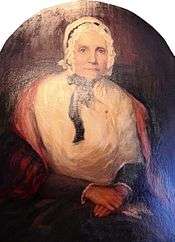


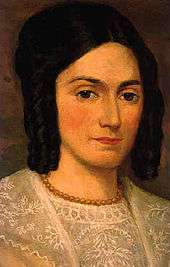

.jpg)
